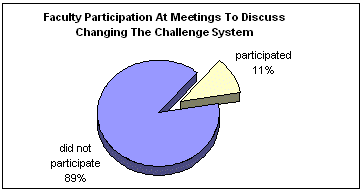To continue where we left off in Part 1,we will resume our examination of the flaws in the research process of a major institutional decision.
Flawed Research (continued)
I then interviewed faculty members about the 2003 summer meeting and I began to learn that this decision making process was also a victim of selective sampling.
After interviewing over fifty faculty members who attended the meeting I discovered that once the topic of changing the challenge system was proposed, a number of faculty members left the meeting once the discussion centered on eliminating the system as opposed to identifying and fixing any known problems.
Director Albaugh used this mass walk-out as pretext for his offering the opportunity to faculty members an avenue of input. If they didn’t want to participate then he wouldn’t consider their opinions, nor would he consider their numbers when determining the statistics used to support eliminating the challenge system.
Unfortunately, that doesn’t serve as a justifiable reason for dismissing their opinions en masse. President Kimpton later acknowledged this incident in an email where he wrote:
“The meetings that led to this change were open to anyone who wanted to participate. I cannot speak to why more did not participate in the meetings. They certainly were not secret.”

During my interview with President Kimpton, I learned that only 11% of the faculty participated in the full meeting. So when Director Albaugh and President Kimpton refer to the “overwhelming faculty members” they are only considering those participants.
To compound this problem, when I asked President Kimpton if he would support eliminating the challenge system if a majority of the faculty members did not approve, he said:
“I can assure you that I would not support these changes if there were a 50/50 split among our faculty members.”
Unfortunately, this wasn’t the last time selective sampling was used in this process. During my interview with President Kimpton, he said that since the beginning of his term this past winter,
“I’ve met with over 1,500 alumni and discussed changing the challenge system and the overwhelming majority had positive responses”
I then followed up by telling him that I had interviewed dozens of Interlochen alumni who currently hold or are retired from prominent positions among America’s most prestigious orchestras. They all credited their experiences with the challenge system as contributing directly to their success later in life as a professional musician.
President Kimpton responded by saying,
“Those Alumni shouldn’t have any relevant input in our decision to change the challenge system.”
Yet moments before, he had used the figure of 1,500 alumni to help support his decision. To only consider the opinions of those you wish will always lead to a divisive decision that serves the best interests of no one and misleads others into believing the research process was sound.
During my interviews with faculty members I began to run across one of the more disturbing problems with this decision making process, coercion.
I had four faculty members tell me, unsolicited, that Director Albaugh made them feel uncomfortable about retaining their teaching positions the following summer if they continued to complain to him about changing the challenge system.
Since the faculty are not tenured, their summer teaching contracts are renewed annually, and Director Albaugh is the individual that determines who receives renewals and who doesn’t. So now Interlochen has moved from an institutional attitude where discussion to change the challenge system is not permitted to one where discussion to not change the challenge system is not permitted. The pendulum has simply swung to the other side instead of coming to rest in the middle.
Conclusions
This decision making process started with a flawed principle and compounded that mistake at nearly every point in its development. By instituting a “top-down” decision making process from administrators to a “bottom-up” program that was implemented by faculty members, those responsible for the final decisions were continually compromised. Those compromises include:
- The decision to eliminate the challenge system by Director Albaugh was founded more in personal feelings and distributing “pay back”, therefore creating a negative situation of two wrongs don’t make a right.
- In order to justify those motives, a significant portion of the institution’s stakeholders were excluded from being included in the statistical evidence supporting the final decision. This is indicative of selective sampling.
- The failure to consider the opinions of successful professional alumni that found the challenge system was beneficial and only consider opinions of those that agreed with eliminating the challenge system beneficial shows another use of selective sampling to gather supporting data.
- Some of the faculty members who attempted to voice concern over their exclusion from the research process were coerced into remaining quiet by intimidation.
- There were never any written surveys distributed to faculty members in order to document opinions and use as reference material while evaluating the value of the challenge system. This led to a lack of documentation problem.
- By appointing faculty members to serve as area coordinators based solely on their agreement with his positions as opposed to allowing the faculty to nominate and/or elect members, Director Albaugh circumvented the lines of communication between faculty and himself.
- The failure on part of Director Albaugh to evaluate, maintain, improve, and offer proper training to incoming faculty members contributed to the steady deterioration of the challenge system. This is a clear failure to implement an oversight component that all system based instruction typically requires.
The overwhelming amount of evidence in this process points to the fact that this decision is a classic representation of a “top-down” decision making model; where evidence is gathered in such a way as to only support a predetermined decision.
No more than 11% of Interlochen’s music faculty was ever consulted directly during this process and there is no documentation to support any of Director Albaugh’s research.
In my investigation I have more than four times that amount of documented interviews with current music faculty (in spite of the deliberate attempts by the Interlochen communications department to prevent just that). Additionally, I’ve interviewed dozens of former faculty members, representatives of the Interlochen Alumni Board, and received hundreds of emails from Interlochen alumni.
 Here are my conclusions, based on the 70% of current music faculty I interviewed:
Here are my conclusions, based on the 70% of current music faculty I interviewed:
- 18% were in favor of completely eliminating the challenge system.
- 22% were in favor of keeping the challenge system the way it has been.
- 60% were in favor of improving the challenge system but not eliminating it.
These were among the most requested improvements:
- Have one additional sectional during the week and/or extend the length of the existing sectionals.
- Institute more of a universal method of administering challenges.
- Create a better support system and expanded reference material related to the logistical nature of challenges.
All but 85 of the faculty members I interviewed were open minded enough and willing to try a new system, even the one based on Director Albaugh’s incomplete and biased research. That just goes to show you how unprejudiced and flexible music teachers really are. In the end, they are concerned for the student’s best interests.
My concern is that the Interlochen administration is willing to abuse that generous nature to eliminate the challenge system forever.
In the end, the final say rests with the board of directors, or in Interlochen’s case, the Board of Trustees. It’s been my experience that even when the executive board members are presented with a preponderance of evidence that is contrary to a current course of action they support, they will nevertheless resist to alter their course or replace administrators at the heart of a problem.
For whatever reason, most board members shy away from acknowledging mistakes, even if it’s been demonstrated that they’ve been presented flawed information. So it’s unknown if the current Board Chair, Harry “Scrub” Calcutt will consider reviewing the decision to eliminate the challenge system or not.
Given my email conversation with Mr. Calcutt, he appears to be convinced that the research related to eliminating the challenge system was conducted properly. And without evidence to the contrary, I wouldn’t fault him for that.
But now that contrary evidence has been presented, I would hope that he is more open minded and courageous enough to react in a fashion outside of the stereotypical executive board member.
Postlude
With the information I was able to collect by talking to faculty, alumni, and recent summer camp students, I was even able to construct an improved version of the challenge system that address all of the issues that concerned faculty members as well as the marketing issues of the administration.
I won’t take the space to publish that information here, but feel free to send me an email if you’re interested in learning more about it.
I’ve determined that I’m going to wait and publish the voluminous amount of information related to this issue over the next several weekends. Those articles will contain:
- Details about the new system which replaced the challenge system.
- Accounts from professional musicians about their experiences with the challenge system when they were Interlochen students and how they feel it’s contributed to their success.
- Descriptions from faculty members about their views of the challenge system and how it benefits students (in one case it was absolutely poetic).
- Descriptions from faculty members that thought the challenge system wasn’t beneficial to students at all and in some cases they believe it was harmful.
There is so much information and testimonials that I may have to take a few weekends to publish it all, but I can ensure everyone that I won’t leave anything out from the readers who took the time to write to me about their Interlochen experiences.


